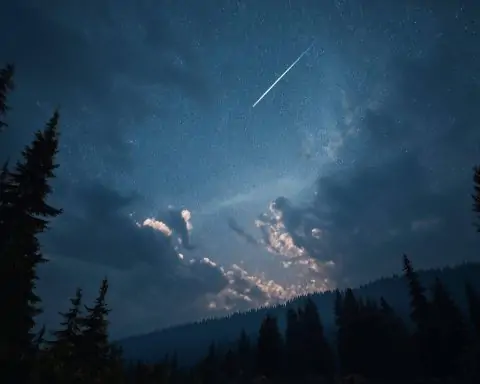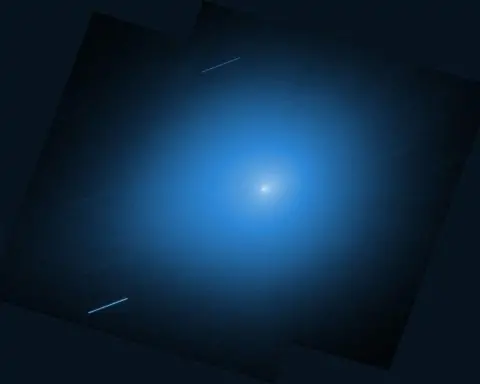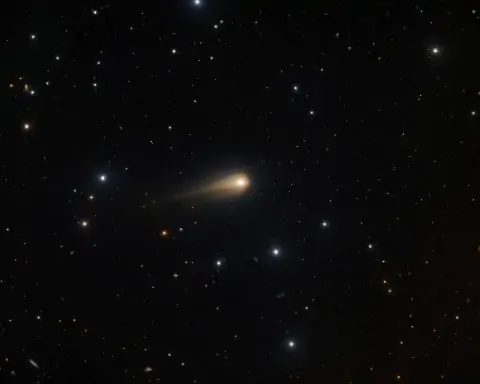- China’s Zhongxing-9C satellite was launched on June 20, 2025, atop a Long March 3B from Xichang, marking the full localization of Chinese broadcast satellites in the 582nd Long March flight.
- SpaceX launched the Starlink 10-34 mission from Cape Canaveral Space Force Station, deploying 27 Starlink satellites and bringing the active constellation to nearly 8,000, with the booster marking its fifth flight.
- Rocket Lab’s Get The Hawk Outta Here mission placed four HawkEye 360 satellites into orbit, including three microsats for RF geolocation and the experimental Kestrel-0A.
- EarthDaily launched its first satellite to begin a ten-satellite constellation delivering AI-powered daily global imagery for change detection.
- ESA’s Biomass satellite released its first images using P-band SAR that penetrates vegetation, snow, and sand to reveal underground structures and measure forest biomass and carbon storage.
- The Vera C. Rubin Observatory released its first images with the LSST camera, kicking off a 10-year Legacy Survey of Space and Time to map the Southern Hemisphere sky.
- NASA’s James Webb Space Telescope captured the first direct image of exoplanet TWA 7b, a Saturn-mass planet about 110 light-years away, using the MIRI instrument and starlight-masking.
- Axiom Space’s Ax-4 mission docked with the International Space Station, carrying four private astronauts from Hungary, India, and Poland alongside Peggy Whitson for a 14-day stay conducting science experiments and outreach.
- Asteroid 2024 YR4 has a 4.3% chance of striking the Moon in 2031-2032, potentially sending debris toward Earth and causing the largest lunar impact in about 5,000 years.
- The long-defunct Relay 2 satellite, inactive since 1967, emitted a powerful radio pulse in June 2024 after nearly 60 years of silence, likely caused by electrostatic discharge or a micrometeorite impact.
This Week in Space: New Frontiers, Private Astronauts, and the Next Era of Observation
Table of Contents
1. Introduction 2. Space Launches and Satellite Milestones- China’s Zhongxing-9C: Full Localization of Broadcast Satellites
- SpaceX Starlink Launches and Global Connectivity
- Rocket Lab and HawkEye 360: Expanding RF Intelligence
- EarthDaily and Next-Gen Earth Observation
- ESA and Biomass: Unveiling Earth’s Hidden Structures
- Finland, Spain, and Brazil: National Satellite Initiatives
- Asteroid YR4 and the Moon: A Looming Threat
- Meteor Fireballs Over the U.S.
- Defunct Satellites: NASA’s Relay 2 Wakes Up
- ESA, Sentinel, and Disaster Response
- Satellites and Wildfire Management
- French Tax and Satellite Surveillance
- China Star Valley: A New Space Industry Hub
- Sirius Space Services and SmallSat Launch Access
- Satellite IoT and Navigation Innovations
Introduction
The past week in space has been a showcase of humanity’s accelerating reach into the cosmos and our deepening reliance on space-based technologies. From the launch of fully localized Chinese broadcast satellites to the first images from the Vera C. Rubin Observatory, the landscape of space exploration and utilization is evolving at breakneck speed.This comprehensive review covers the latest launches, scientific breakthroughs, private astronaut missions, looming asteroid threats, and the ever-growing role of satellites in everything from climate monitoring to tax enforcement. Whether you’re an industry professional, an amateur astronomer, or simply a curious reader, this roundup will bring you up to speed on the most significant developments shaping our future in space.Space Launches and Satellite Milestones
China’s Zhongxing-9C: Full Localization of Broadcast Satellites
China has achieved a significant milestone in its space program with the successful launch of the Zhongxing-9C satellite, marking the full localization of its broadcast TV satellites. This achievement means China no longer relies on imported broadcast satellite models, reinforcing its independent satellite communication network and supporting hundreds of TV and radio programs nationwide.The Zhongxing-9C, launched on a Long March 3B rocket from the Xichang Satellite Launch Center, features enhanced performance and coverage, and entered its designated orbit successfully. This mission was the 582nd flight of the Long March rocket series, underscoring the maturity and reliability of China’s launch infrastructure.Key Points:- Full localization of Chinese broadcast satellites.
- Enhanced national satellite communication and technology independence.
- Successful deployment via Long March 3B.
- Supports hundreds of TV and radio programs.
SpaceX Starlink Launches and Global Connectivity
SpaceX continues to dominate the commercial launch market, with multiple successful Falcon 9 launches this week, deploying 27 Starlink satellites in each mission. These launches, including the Starlink 10-34 mission, further expand the Starlink satellite constellation, which now approaches 8,000 active satellites, enhancing global satellite internet coverage.The launches were notable for their operational resilience, taking place after severe Florida storms and marking the booster’s fifth flight with a safe drone ship landing. The missions also coincided with the 10th anniversary of a Falcon 9 mishap, highlighting SpaceX’s progress in reliability and reusability.Key Points:- Multiple Starlink launches from Cape Canaveral.
- Starlink network nears 8,000 active satellites.
- Booster reusability and operational milestones.
- Starlink services expanding into new markets (e.g., Vietnam, T-Mobile partnership).
Rocket Lab and HawkEye 360: Expanding RF Intelligence
Rocket Lab’s “Get The Hawk Outta Here” mission successfully launched four HawkEye 360 satellites, including three microsats for RF geolocation and the experimental Kestrel-0A. This mission enhances HawkEye 360’s global RF intelligence capabilities, supporting maritime domain awareness, spectrum monitoring, and defense applications.Key Points:- Four HawkEye 360 satellites launched.
- Expands global RF intelligence and geolocation capabilities.
- Part of a multi-launch contract for constellation growth.
EarthDaily and Next-Gen Earth Observation
EarthDaily has launched its first satellite, initiating a ten-satellite constellation that will deliver AI-powered, daily global imagery. This system is designed for advanced change detection, supporting smarter decisions for governments and industries in agriculture, disaster response, and environmental monitoring.Key Points:- Next-generation Earth observation with daily revisit.
- AI-powered analytics for rapid change detection.
- Supports government and industry decision-making.
ESA and Biomass: Unveiling Earth’s Hidden Structures
The European Space Agency (ESA) has released the first images from its Biomass satellite, equipped with P-band synthetic aperture radar. This technology can penetrate dense forests, snow, sand, and polar ice, revealing underground structures and enabling precise measurement of forest biomass and carbon storage.Early images have revealed hidden features in the Amazon, Sahara, and Antarctica, marking a major advance in global forest and environmental observation. The satellite’s data will be crucial for climate change research and carbon accounting.Key Points:- P-band radar penetrates vegetation, snow, and sand.
- Reveals hidden structures and measures carbon stocks.
- Supports climate change research and ecosystem monitoring.
Finland, Spain, and Brazil: National Satellite Initiatives
Finland is acquiring its first domestically produced SAR satellites from Iceye, enabling all-weather, day-and-night reconnaissance for defense and intelligence. This marks a major step in Finland’s space-based national security development.Spain has approved the €900 million Paz II program, which will design, develop, and launch two new Earth observation satellites with radar capabilities, ensuring continued strategic detection and reconnaissance until at least 2042.Brazil is preparing to launch the Aldebaran-I nanossatellite, which will aid in maritime rescue and wildfire monitoring using environmental sensors and AI. The project may expand into a constellation for continuous coverage.Key Points:- Finland: Indigenous SAR satellites for defense.
- Spain: Paz II program for strategic Earth observation.
- Brazil: Aldebaran-I cubesat for rescue and environmental monitoring.
Astronomy’s New Eyes: The Vera C. Rubin Observatory
First Images and Scientific Promise
The NSF-DOE Vera C. Rubin Observatory in Chile has released its first images, captured with the world’s most powerful digital camera. In just 10 hours of testing, the observatory imaged millions of galaxies, stars, and asteroids, marking the start of a 10-year mission to map the universe in unprecedented detail.The observatory’s Legacy Survey of Space and Time (LSST) will scan the Southern Hemisphere sky nightly, enabling discoveries in dark matter, dark energy, cosmic evolution, and near-Earth asteroid detection.Key Points:- First light: millions of celestial objects captured.
- 10-year survey to map the dynamic universe.
- Focus on dark matter, dark energy, and cosmic events.
Technological Innovations and Survey Goals
The Rubin Observatory’s LSST camera is the largest digital camera ever built for astronomy, enabling rapid, high-resolution imaging of vast sky areas. The observatory’s data pipeline will process and share millions of nightly detections, supporting 3D galaxy mapping and real-time alerts for transient cosmic events.Key Points:- World’s largest digital camera (LSST).
- Real-time data processing and sharing.
- Unprecedented survey depth and cadence.
James Webb Space Telescope: Direct Exoplanet Imaging
TWA 7b: A New Benchmark in Exoplanet Science
NASA’s James Webb Space Telescope (JWST) has captured its first direct image of an exoplanet, TWA 7b, a Saturn-mass planet orbiting the young star TWA 7. Using the MIRI instrument and advanced starlight-masking techniques, astronomers identified the faint planet within the star’s debris disk.This marks a significant milestone in exoplanet discovery, providing new insights into young planetary systems and the smallest-mass exoplanet directly imaged to date.Key Points:- First direct image of exoplanet TWA 7b by JWST.
- Saturn-mass planet, 110 light-years away.
- Advances in imaging techniques and planetary science.
How Solar Flares Shape Exoplanet Habitability
New research using computer models shows that solar flares from host stars can dramatically alter the atmospheres and climates of exoplanets, impacting their habitability. Flares can trigger complex chemical reactions, change wind patterns, and deplete protective ozone layers, especially around red dwarf stars like TRAPPIST-1.Key Points:- Solar flares can strip exoplanet atmospheres.
- Impacts habitability and climate modeling.
- Especially relevant for planets around active stars.
Private Spaceflight and International Collaboration
Axiom-4: New Astronauts, New Nations
Axiom Space’s fourth mission, Axiom-4 (Ax-4), launched astronauts from Hungary, India, and Poland to the International Space Station (ISS) for the first time, alongside veteran astronaut Peggy Whitson. The mission underscores the rise of commercial spaceflight and international collaboration.Key Points:- First Indian, Polish, and Hungarian astronauts on a private ISS mission.
- 14-day stay for scientific experiments and outreach.
- Docking and integration with ISS Expedition 73.
Cultural Exchange and Science on the ISS
The Ax-4 mission is notable not only for its scientific agenda but also for its cultural exchange. Astronauts brought international foods—mango nectar from India, space chocolate from Hungary, and pierogis from Poland—highlighting the diverse traditions represented on this flight.The crew will conduct over 60 science experiments, STEM outreach, and microgravity research, advancing knowledge in space health, exercise, and technology.Key Points:- International cuisine and cultural exchange on the ISS.
- Over 60 science and outreach experiments.
- Milestone for India’s space journey and national pride.
Space Hazards: Asteroids, Meteors, and Space Debris
Asteroid YR4 and the Moon: A Looming Threat
Asteroid 2024 YR4 (also called YR4) has a non-negligible chance of colliding with the Moon in 2031 or 2032. Such an impact could create a massive debris cloud, threatening Earth’s satellites and potentially causing a spectacular meteor shower. Up to 10% of lunar ejecta may reach Earth’s orbit, posing a significant risk to satellite infrastructure and global communications.NASA and ESA are actively monitoring the asteroid and considering planetary defense strategies, including possible diversion missions.Key Points:- 4.3% chance of lunar impact in 2031/2032.
- Debris could threaten satellites and create meteor showers.
- Largest lunar impact in 5,000 years if it occurs.
- International planetary defense under discussion.
Meteor Fireballs Over the U.S.
A series of dramatic meteor fireballs lit up the skies across the southeastern United States, with one event resulting in debris landing in Georgia and causing minor property damage. NASA confirmed the fireball was caused by a three-foot asteroidal fragment traveling over 30,000 mph, releasing energy equivalent to 20 tons of TNT.Such events are rare over populated regions and highlight the importance of satellite and radar monitoring for atmospheric entries.Key Points:- Multiple fireballs observed, debris recovered in Georgia.
- Sonic booms and flashes detected by satellites and Doppler radar.
- Meteorite hunters and scientists searching for valuable fragments.
Defunct Satellites: NASA’s Relay 2 Wakes Up
Australian astronomers detected a powerful radio signal from NASA’s long-dead Relay 2 satellite, inactive since 1967. The brief, intense burst was likely caused by an electrostatic discharge or a micrometeorite impact, highlighting the unpredictable behavior of space debris and the challenges in monitoring inactive satellites.Key Points:- Relay 2 emitted a radio pulse after nearly 60 years.
- Possible causes: micrometeorite impact or electrostatic discharge.
- Implications for orbital debris monitoring and satellite end-of-life planning.
Earth Observation and Climate Monitoring
ESA, Sentinel, and Disaster Response
ESA’s Sentinel satellite constellation played a vital role in tracking Australia’s extreme floods, providing high-resolution imagery for environmental management and disaster response. The new Biomass satellite’s radar capabilities are also being used to monitor forests, carbon stocks, and ecosystem changes due to climate change.Key Points:- Sentinel-3 and Biomass satellites support flood and forest monitoring.
- Radar imagery penetrates clouds and vegetation.
- Data aids rapid disaster response and climate research.
Satellites and Wildfire Management
NASA’s FireSense Program, in partnership with the University of Utah, is providing fire crews with real-time wildfire data using satellites, drones, and AI. This technology enables rapid response and improved prediction of fire behavior, enhancing firefighter safety and wildfire management.Key Points:- Real-time wildfire data for first responders.
- Integration of satellites, drones, and AI.
- Improved prediction and safety for fire crews.
French Tax and Satellite Surveillance
French tax authorities are using satellite imagery and AI to detect undeclared property improvements, such as swimming pools, leading to increased tax revenue and fines. This highlights the growing use of space-based technology for property surveillance and enforcement.Key Points:- Satellite imagery used for property tax enforcement.
- AI aids in detecting undeclared structures.
- Expanding applications of Earth observation data.
Commercial Space and Industry Trends
China Star Valley: A New Space Industry Hub
Wuhan’s “China Star Valley” is rapidly emerging as a commercial space industry hub, boasting advanced satellite manufacturing, rocket production, and a complete space industry chain. With smart satellite factories and robust government support, it aims to mass-produce satellites and rockets, driving China’s commercial space sector forward.Key Points:- Integrated space industry cluster in Wuhan.
- Mass production of satellites and rockets.
- Government support and advanced infrastructure.
Sirius Space Services and SmallSat Launch Access
French start-up Sirius Space Services is developing reusable launchers to provide affordable, agile, and sustainable launches for small satellites. Aiming for a 2027 commercial debut, the company emphasizes full reusability and advanced manufacturing, opening space access for France, Europe, and beyond.Key Points:- Reusable launchers for small satellites (175–1100 kg).
- Focus on affordability, agility, and sustainability.
- Commercial launch debut targeted for 2027.
Satellite IoT and Navigation Innovations
China Mobile has launched two fully domestic RISC-V satellite communication chips to boost satellite IoT coverage and address cellular blind spots. Wuhan Mengxin Technology’s new BeiDou SoC chips mark China’s entry into the BeiDou 2.0 era, enabling widespread satellite navigation applications in IoT, safety, and smart cities.A palm-sized black box developed by Chengxin Zhilian enables autonomous vehicles to operate with centimeter-level precision even in satellite signal blind spots, using advanced MEMSIMU inertial sensors and AI algorithms.Key Points:- RISC-V chips for satellite IoT and AI integration.
- BeiDou 2.0 chips for navigation and smart city applications.
- MEMSIMU-powered navigation for autonomous vehicles in blind zones.
Celestial Events and Public Engagement
Moon, Mars, and Regulus Alignment
Skywatchers can witness a rare alignment of the crescent Moon, Mars, and the bright star Regulus after sunset on June 28 and 29. The trio will be visible above the western horizon, with a possible lunar occultation of Mars for some South American viewers.Key Points:- Rare celestial alignment visible after sunset.
- Best viewed with a telescope.
- Occultation possible in some regions.
Meteor Showers and the Northern Lights
The Bootids meteor shower peaks on June 27, with unpredictable rates and best visibility away from city lights. Meteor activity is expected to increase in July, with the moon phase favoring morning observations.NOAA forecasts the northern lights (aurora borealis) will be visible in 15 U.S. states on June 24-25, with best viewing in Alaska and the northern tier. For those outside the auroral zone, livestreams are recommended.Key Points:- Bootids meteor shower: June 27 peak.
- Meteor activity outlook: higher rates after July 15.
- Aurora borealis visible in northern U.S. states.
Outlook: The Next Chapter in Space
This week’s developments underscore the rapid evolution of the space sector—technologically, scientifically, and commercially. The localization of satellite manufacturing, the rise of private astronaut missions, and the deployment of new observatories and Earth-monitoring satellites are reshaping our relationship with space.Looking ahead:- The Vera C. Rubin Observatory and JWST will drive discoveries in cosmology and exoplanet science.
- New satellite constellations will enhance connectivity, disaster response, and climate monitoring.
- International collaboration and private sector innovation will continue to democratize access to space.
- Ongoing vigilance is needed for space hazards, from asteroids to orbital debris.
References
- [67]
- [68]
- [69]
- [70]
- [71]
- [72]
- [73]
- [74]
- [75]
- [76]
- [77]
- [78]
- [James Webb Space Telescope Captures First Direct Image of Exoplanet](https://petapixel.com/2025/
More today’s sources
China Achieves Full Localization of Broadcast Satellites with Zhongxing-9C Launch
China successfully launched the Zhongxing-9C satellite, marking the full localization of its broadcast TV satellites. The new satellite, with enhanced performance and coverage, replaces imported models and strengthens China’s independent satellite communication network, supporting hundreds of TV and radio programs and advancing national satellite technology.
Continue reading on [79]
SpaceX Launches Falcon 9 with 27 Starlink Satellites After Florida Storms
SpaceX successfully launched a Falcon 9 rocket from Cape Canaveral, deploying 27 Starlink satellites into low-Earth orbit after severe weather cleared. The mission marked the booster’s fifth flight and a safe drone ship landing. The event coincided with the 10th anniversary of a previous Falcon 9 mishap and highlighted new leadership at Space Launch Delta 45.
Continue reading on [80]
SpaceX Launches Starlink 10-34 Mission from Cape Canaveral
SpaceX successfully launched its Starlink 10-34 mission from Cape Canaveral Space Force Station in Florida. This mission continues the expansion of the Starlink satellite constellation, enhancing global satellite internet coverage and demonstrating SpaceX’s ongoing commitment to space-based connectivity solutions.
Continue reading on [81]
First Images from Vera C. Rubin Observatory Reveal Dynamic Universe
The NSF-DOE Vera C. Rubin Observatory has released its first imagery, capturing millions of galaxies, stars, and asteroids in just 10 hours of testing. This marks the start of a 10-year mission to map the universe in unprecedented detail, advancing our understanding of dark matter, dark energy, and cosmic evolution.
Continue reading on [82]
Defunct NASA Satellite Relays Signal Decades After Shutdown
Australian astronomers detected a powerful radio signal from the long-dead NASA satellite Relay 2, inactive since 1967. The brief, intense burst likely resulted from electrostatic discharge or a micrometeorite impact. This rare event highlights the unpredictable behavior of space debris and the challenges in monitoring inactive satellites.
Continue reading on [83]
China Successfully Launches Zhongxing-9C Satellite with Long March 3B Rocket
China launched the Zhongxing-9C satellite on June 20 using a Long March 3B rocket from Xichang Satellite Launch Center. The satellite entered its designated orbit successfully, marking the 582nd flight of the Long March rocket series. The mission was declared a complete success.
Continue reading on [84]
Vera Rubin Observatory Unveils First Celestial Image with Record-Breaking Telescope
The Vera C. Rubin Observatory in Chile has released its first images, showcasing its revolutionary telescope and the world’s most powerful digital camera. This facility will map the Milky Way, detect near-Earth asteroids, and probe dark matter, promising to transform our understanding of the universe over a ten-year continuous survey.
Continue reading on [85]
Vera Rubin Observatory Unveils Deep Space Images with World’s Largest Digital Camera
The Vera C. Rubin Observatory in Chile has released its first deep space images using the LSST camera, the world’s largest digital camera. These detailed photos, including the Virgo cluster, will help astronomers study dark matter and dark energy, imaging billions of galaxies during its 10-year Legacy Survey of Space and Time (LSST) mission.
Continue reading on [86]
Satellite Images Reveal Iran Expanding Fordow Nuclear Site After US Bombings
Latest satellite images from Maxar Technologies show Iran expanding the Fordow nuclear facility after US B-2 bombings. Fresh earth movement, new access roads, and sealed tunnel entrances are visible, suggesting Iran may have prepared for the strike and possibly relocated enriched uranium. The images raise concerns about Iran’s nuclear capabilities post-attack.
Continue reading on [87]
SpaceX Launches 27 Starlink Satellites in First of Saturday Doubleheader
SpaceX successfully launched 27 Starlink satellites into low Earth orbit with a Falcon 9 rocket, marking the first of two scheduled missions on June 28. The booster landed safely on a droneship, and a second launch later in the day could push the Starlink network beyond 7,900 active satellites.
Continue reading on [88]
ESA Satellite Releases First Earth Images from Orbit
The European Space Agency (ESA) has unveiled the first images from its new Earth-observing satellite, showcasing forests, deserts, and glaciers. These initial photos, revealed at the Living Planet Symposium, highlight the satellite’s advanced radar system and its potential to help scientists monitor carbon storage and ecosystem changes due to climate change.
Continue reading on [89]
T-Mobile Sets Starlink Satellite Data Launch Date for Messaging Apps on Phones Without Coverage
T-Mobile will launch its Starlink satellite service for voice and text on July 23, enabling messaging apps like WhatsApp and X on phones without carrier coverage. The service, requiring no special equipment, expands connectivity to remote areas and will offer satellite internet in October, benefiting users across multiple carriers.
Continue reading on [90]
NASA and University of Utah Collaborate to Deliver Real-Time Wildfire Data to Fire Crews
University of Utah professors are partnering with NASA’s FireSense Program to provide fire crews with real-time wildfire data using satellites, drones, and AI. This technology enables rapid response and improved prediction of fire behavior, aiming to enhance firefighter safety and wildfire management across Utah.
Continue reading on [91]
Axiom-4 Mission: Shubhanshu Shukla Becomes 634th Astronaut to Reach Space
Shubhanshu Shukla became the 634th astronaut to reach space, joining the Axiom-4 mission to the International Space Station. Alongside three other astronauts, he will spend 14 days conducting scientific experiments and outreach, marking a significant milestone for India’s space journey.
Continue reading on [92]
Stunning New Multi-Wavelength Image of Andromeda Galaxy Unveiled
A composite image of the Andromeda Galaxy has been created using data from multiple space telescopes—including Chandra, XMM-Newton, GALEX, Spitzer, IRAS, COBE, Planck, and Herschel—and ground-based observatories. This multi-wavelength view reveals unprecedented details, from X-rays to radio waves, highlighting Andromeda’s structure and its supermassive black hole.
Continue reading on [93]
EarthDaily Launches Next-Gen Earth Observation Satellite, Ushering in New Era
EarthDaily has successfully launched its first satellite, marking a major milestone in deploying a next-generation Earth observation constellation. The system delivers AI-powered, daily global imagery for advanced change detection, supporting smarter decisions for governments and industries. This launch initiates a ten-satellite constellation, set to revolutionize remote sensing and analytics.
Continue reading on [94]
SpaceX Prepares to Launch Starlink LEO Satellite Services in Vietnam
SpaceX is finalizing procedures to establish a wholly foreign-owned company in Vietnam to provide Starlink LEO satellite services. Vietnamese regulations now allow foreign investors full ownership in satellite telecom ventures, paving the way for innovative satellite internet and telecommunications services with broad coverage and enhanced digital transformation.
Continue reading on [95]
Satellite Images Reveal Construction Near Iran’s Fordow Nuclear Facility After US Airstrike
Satellite imagery from Maxar Technologies shows construction activity near Iran’s Fordow nuclear facility just days after a US airstrike with heavy bunker-buster bombs. The images reveal visible craters and ongoing work by Iranian crews, possibly repairing damage and rebuilding roads, highlighting the aftermath of recent military actions and ongoing nuclear tensions.
Continue reading on [96]
Spain Approves €900M Paz II Earth Observation Satellite Program
The Spanish government has approved the €900 million Paz II program, involving the design, development, and launch of two new Earth observation satellites with radar capabilities. These satellites will ensure continued strategic space-based detection and reconnaissance after the current Paz satellite retires, supporting national security and defense operations until at least 2042.
Continue reading on [97]
How to See the Crescent Moon, Mars, and Regulus Align This Weekend
Stargazers can witness a rare alignment of the crescent moon, Mars, and the bright star Regulus after sunset on June 28 and 29. The trio will be visible above the western horizon, with a possible lunar occultation of Mars for some South American viewers. Use a telescope for the best views.
Continue reading on [98]
James Webb Space Telescope Captures First Direct Image of Exoplanet
NASA’s James Webb Space Telescope has captured its first direct image of an exoplanet, TWA 7 b, a Saturn-mass planet orbiting the young star TWA 7. Using Webb’s MIRI instrument and advanced imaging techniques, astronomers identified the faint planet within the star’s debris disk, marking a significant milestone in exoplanet discovery.
Continue reading on [99]
Finland to Acquire Indigenous SAR Satellites for All-Weather Reconnaissance
Finland’s Ministry of Defence has partnered with Iceye to procure its first domestically produced SAR satellites. These satellites will enable all-weather, day-and-night reconnaissance, significantly boosting Finland’s defense and intelligence capabilities. The initiative marks a major step in Finland’s space-based national security development.
Continue reading on [100]
Hainan Changguang Satellite Explores High-Resolution Satellite Remote Sensing Applications
Hainan Changguang Satellite is advancing data processing and high-resolution satellite remote sensing in Hainan. The company provides monitoring services using satellite imagery for urban management and plans to expand its remote sensing products domestically and internationally, especially to Belt and Road countries, leveraging AI and local policy support.
Continue reading on [101]
Rare Moon-Mars Conjunction to Illuminate Pre-Dawn Sky on June 30
A rare Moon-Mars conjunction will occur on June 30, offering skywatchers a stunning view as the crescent Moon and brightening Mars appear close together before dawn. This celestial event is notable for its timing and visibility, though monsoon clouds may obscure the spectacle for many in India.
Continue reading on [102]
Why ‘China Star Valley’ is Rising in Wuhan: Commercial Space Industry Hub
Wuhan’s ‘China Star Valley’ is rapidly emerging as a commercial space industry hub in central China, boasting advanced satellite manufacturing, rocket production, and a complete space industry chain. With smart satellite factories and robust government support, it aims to mass-produce satellites and rockets, driving China’s commercial space sector forward.
Continue reading on [103]
China’s Einstein Probe Satellite Discovers New Transient X-ray Source
China’s Einstein Probe (EP) satellite has detected a new type of transient X-ray source (EP240414a), offering fresh insights into stellar death. The event, 4 billion light-years away, was captured thanks to EP’s wide-field, high-sensitivity X-ray technology, marking a breakthrough in supernova and relativistic jet research.
Continue reading on [104]
Rocket Lab Launches HawkEye 360 Satellites on ‘Get The Hawk Outta Here’ Mission
Rocket Lab’s ‘Get The Hawk Outta Here’ mission successfully launched four HawkEye 360 satellites, including three microsats for RF geolocation and the experimental Kestrel-0A. This mission enhances HawkEye 360’s global RF intelligence capabilities and is part of a multi-launch contract expanding their satellite constellation.
Continue reading on [105]
Meteor Activity Outlook: 28 June–4 July 2025 – Best Viewing Tips and Rates
Meteor activity increases in July for the northern hemisphere, with higher rates expected after July 15. The moon phase will favor morning observations, with estimated hourly rates of 10–13 meteors in dark skies. The outlook provides tips on finding radiant positions and maximizing your meteor-watching experience.
Continue reading on [106]
How to Watch the Bootids Meteor Shower on June 27, 2025
The Bootids meteor shower peaks Friday, June 27, 2025, as Earth passes through comet 7P/Pons-Winnecke’s tail. Its radiant is in the constellation Boötes, low on the western horizon. Visibility is best away from city lights. Bootids are unpredictable, so patience and dark skies increase your chances of seeing these meteors.
Continue reading on [107]
European Biomass Satellite Unveils Unprecedented Radar Images of Amazon, Sahara, and Antarctica
The ESA’s new Biomass satellite released its first radar images revealing underground structures in the Sahara, Antarctic glaciers, and Amazon forests. Using P-band synthetic aperture radar, it penetrates snow, sand, and dense vegetation, enabling precise carbon measurement and climate monitoring. The mission marks a major advance in global forest and environmental observation.
Continue reading on [108]
James Webb Telescope Captures First Direct Images of Exoplanet TWA 7b
The James Webb Space Telescope has captured the first direct images of exoplanet TWA 7b, a Saturn-mass planet 110 light years away. This breakthrough provides new insights into young planetary systems and marks the smallest-mass exoplanet directly imaged to date, using innovative starlight-masking technology.
Continue reading on [109]
Hungarian, Indian, and Polish Astronauts Launch to ISS on Axiom-4 Mission
Axiom Space’s fourth mission, Axiom-4, launched astronauts from Hungary, India, and Poland to the International Space Station for the first time. Using a SpaceX Falcon 9 rocket and Crew Dragon capsule, the mission highlights the rise of commercial spaceflight and international collaboration in space exploration.
Continue reading on [110]
Space Florida Delegation to Forge UK Partnerships at North East Space Conference
Space Florida’s vice president will keynote the North East Space Conference in Durham, aiming to build UK-US space partnerships. The visit highlights the North East’s growing space sector and seeks to connect UK companies with Florida’s booming space industry, including opportunities linked to Cape Canaveral and satellite technology.
Continue reading on [111]
NASA’s Relay 2 Satellite Emits Powerful Radio Pulse After 60 Years
A long-dead NASA satellite, Relay 2, unexpectedly emitted a powerful radio pulse in June 2024 after nearly 60 years of silence. Astronomers detected the burst using the ASKAP radio telescope. The pulse may have been triggered by a micrometeorite impact or electrostatic discharge, surprising researchers with its intensity and origin.
Continue reading on [112]
Asteroid 2024 YR4 May Hit Moon in 2032, Threatening Satellites and Creating Meteor Shower
Asteroid 2024 YR4 could collide with the Moon in 2032, producing a massive debris cloud. Debris may threaten Earth’s satellites and create a spectacular meteor shower. The event would be the largest lunar impact in 5,000 years, according to NASA and recent research.
Continue reading on [113]
Wuhan Mengxin Technology Propels China’s BeiDou Industry into 2.0 Era with Breakthrough SoC Chips
Wuhan Mengxin Technology has launched high-precision BeiDou SoC chips, marking China’s entry into the BeiDou 2.0 era. These chips offer enhanced sensitivity, low power, and low cost, enabling widespread satellite navigation applications in IoT, safety, and smart cities, and supporting the rapid growth of China’s satellite navigation industry.
Continue reading on [114]
Meteor Fireball Lights Up Skies Across Multiple States
A meteor fireball traveling up to 40,000 mph was seen across several states, with fragments landing in Georgia. Experts explain its visibility over a wide area due to its high altitude. Such events are common, but rarely occur over populated regions, making this incident notable for its minor property damage and widespread observation.
Continue reading on [115]
SpaceX Launches Axiom-4 Private Astronaut Mission to ISS
SpaceX launched the historic Ax-4 mission for Axiom Space, sending four private astronauts—including firsts from India, Poland, and Hungary—aboard the new Dragon “Grace” to the ISS. The crew, led by Peggy Whitson, will spend two weeks conducting over 60 science experiments and STEM outreach events, marking a milestone in commercial spaceflight.
Continue reading on [116]
SpaceX Starship Explosion Sparks Environmental and Legal Concerns
A recent SpaceX Starship explosion allegedly caused the deaths of dolphins and sea turtles, with debris falling into Mexico. Environmentalists and the Mexican government are raising concerns over wildlife impacts and potential international law violations, while SpaceX denies any hazards. The incident highlights growing scrutiny of rocket launch environmental effects.
Continue reading on [117]
NOAA to Shut Down Key Hurricane-Tracking Satellites Amid Atlantic Storm Season
NOAA will permanently end operations of the Defense Meteorological Satellite Program (DMSP), a vital source for hurricane-tracking data, just weeks into the Atlantic storm season. While NOAA assures some data continuity via other satellites, experts warn the loss could hinder real-time hurricane forecasting and public safety.
Continue reading on [118]
Bright Fireball Streaks Across Southeast U.S. Sky, Possible Meteor or Space Debris
A bright fireball lit up the Southeast U.S. sky on June 26, 2025, likely caused by a meteor or space junk. The event, visible in daylight, was reported by over 140 people and left minor damage in Georgia. Such space debris sightings are rare during the day, according to NASA.
Continue reading on [119]
Pentagon Shuts Down Key Hurricane Monitoring Satellites
The Pentagon is abruptly decommissioning satellites from the Defense Meteorological Satellite Program, which provide crucial real-time data for hurricane forecasting. Meteorologists warn this could delay early warnings and storm intensification forecasts, especially at night, as new replacement satellites may not yet be fully operational.
Continue reading on [120]
Why ‘China Star Valley’ is Rising in Wuhan: Commercial Space Industry Cluster
Wuhan’s ‘China Star Valley’ is emerging as a major hub for China’s commercial space industry, focusing on satellite manufacturing, rocket production, and space applications. With advanced infrastructure, leading universities, and government support, it aims to mass-produce rockets and satellites, driving innovation and forming a complete space industry supply chain in central China.
Continue reading on [121]
ESA’s Biomass Satellite Reveals Hidden Structures Beneath Forests and Polar Ice
The ESA’s Biomass satellite released its first images, showcasing its ability to penetrate dense forests and polar ice using advanced P-band synthetic aperture radar. This breakthrough enables precise measurement of forest biomass and carbon storage, offering unprecedented insights into global climate regulation and ecosystem health.
Continue reading on [122]
Sentinel Satellites Boost Flood Monitoring in Australia
The European Space Agency’s Sentinel satellite constellation played a vital role in tracking Australia’s extreme floods in 2025. Sentinel-3 provided high-resolution imagery to monitor water movement, ecological changes, and disaster impacts, enabling better environmental management and rapid response to both slow and fast-onset flood events across the continent.
Continue reading on [123]
Satellite Images Reveal Iranian Construction at Fordow Nuclear Site After US Bunker Buster Strikes
Satellite images from Maxar Technologies show Iranian construction crews rebuilding at the Fordow uranium enrichment facility after US bunker buster bomb strikes. Heavy machinery is repairing roads and infrastructure above the damaged underground site. The International Atomic Energy Agency reports Fordow’s centrifuges are currently inoperable due to the attack.
Continue reading on [124]
NASA Relay 2 Satellite Emits Signal After 57 Years of Silence
Australian astronomers detected a powerful radio pulse from the long-inactive NASA Relay 2 satellite, which ceased operation in 1967. The 30-nanosecond signal, likely caused by an electrostatic discharge, challenges assumptions about dormant spacecraft and could advance orbital debris monitoring technologies.
Continue reading on [125]
ESA Releases First Images from Forest Carbon Stock Observation Satellite
The European Space Agency (ESA) has released the first images from its newly launched forest carbon stock observation satellite. The satellite, equipped with P-band synthetic aperture radar, can penetrate clouds and tree canopies to measure forest biomass, aiding in accurate carbon stock estimation and supporting climate change research.
Continue reading on [126]
Pioneering Satellite Unveils Hidden Rainforest Ecosystems
A pioneering satellite is now able to penetrate dense rainforest canopies, revealing the hidden worlds beneath. This breakthrough allows scientists to better understand rainforest ecosystems, which are crucial for climate change mitigation and biodiversity, as they store billions of tonnes of greenhouse gases and host half the planet’s species.
Continue reading on [127]
Russian Meteor-M Satellite Captures Rare Snowfall in Atacama Desert
The Russian Meteor-M satellite captured images of a rare snowfall in Chile’s Atacama Desert, the driest desert on Earth, where such events occur only once every ten years. This unique phenomenon was reported by Roscosmos via their Telegram channel.
Continue reading on [128]
China Successfully Launches ‘Zhangheng-1’ 02 Electromagnetic Monitoring Satellite
China launched the ‘Zhangheng-1’ 02 geophysical satellite on June 14 using a Long March 2D rocket. This satellite enhances electromagnetic field monitoring for disaster prediction and scientific research, supporting early warning for earthquakes, tsunamis, and other natural disasters. It also strengthens international cooperation and advances China’s space-based disaster management capabilities.
Continue reading on [129]
Moon, Mars, and Regulus Alignment: How to Watch the Celestial Event
Skywatchers can witness a rare alignment of the Moon, Mars, and Regulus from June 28-29, with a close conjunction and even an occultation in some regions. The event is visible about 45 minutes after sunset, offering a spectacular view for astronomy enthusiasts and casual observers alike.
Continue reading on [130]
ESA Releases First Images from Forest Carbon Monitoring Satellite
The European Space Agency (ESA) has released the first images from its newly launched forest carbon monitoring satellite. The satellite, equipped with P-band synthetic aperture radar, can penetrate clouds and tree canopies to measure forest biomass, aiding in accurate carbon stock estimation and supporting climate change research.
Continue reading on [131]
Brazilian Nanossatellite Aldebaran-I to Aid Maritime Rescue and Fire Monitoring
Brazil’s innovative Aldebaran-I nanossatellite, developed by UFMA and AEB, will launch in June via India’s PSLV rocket. This 1U cubesat will locate distressed fishing vessels and monitor wildfires using environmental sensors and AI. The project may expand into a constellation for continuous coverage, enhancing emergency response and environmental monitoring.
Continue reading on [132]
Axiom Space Launches Fourth Private Mission to ISS with International Crew
Axiom Space’s fourth privately-funded mission to the International Space Station launched from Kennedy Space Center, carrying veteran astronaut Peggy Whitson and three international crewmates aboard a new SpaceX Crew Dragon. The mission highlights the growing role of commercial spaceflight and international collaboration in low-Earth orbit research.
Continue reading on [133]
Asteroid YR4 Threatens Moon Impact, Posing Major Risk to Satellites
A city-killer asteroid named YR4 could strike the moon in 2032, raising concerns over a potential meteor shower that may endanger Earth’s satellite systems. Experts warn this could disrupt global communications, navigation, and critical infrastructure, prompting discussions on possible asteroid diversion missions by space agencies.
Continue reading on [134]
ESA Biomass Satellite Uses Radar to Study Earth’s Forests
The ESA Biomass satellite studies Earth’s forests by measuring tree mass using radar waves. This technology overlaps with radar systems used in US military missile warning, adding complexity to the mission. The satellite’s data helps monitor global forest health and carbon storage.
Continue reading on [135]
Vera C. Rubin Observatory Releases First Images from World’s Largest Digital Camera
The Vera C. Rubin Observatory unveiled its first images, captured with the world’s largest digital camera, revealing galaxies, cosmic collisions, and distant cosmic history. This marks the start of a decade-long mission to scan the Southern Hemisphere sky, promising breakthroughs in astronomy and our understanding of the universe.
Continue reading on [136]
James Webb Space Telescope Discovers First Exoplanet, TWA 7b
The James Webb Space Telescope has discovered its first exoplanet, TWA 7b, orbiting a young star 111 light-years away. Using its MIRI instrument, Webb directly imaged this cold, low-mass gas giant, marking a milestone in the study of planet formation and sub-Jupiter-mass planets.
Continue reading on [137]
Finland’s Defense Ministry to Acquire SAR Satellites from Iceye Oy for Military Use
Finland’s Defense Ministry signed a memorandum with Iceye Oy to acquire SAR satellites for defense. These satellites provide high-resolution Earth images in all weather and lighting conditions, enhancing situational awareness and independent reconnaissance capabilities. Iceye Oy already supplies satellite data to Poland and Ukraine, and has launched 30 SAR satellites since 2018.
Continue reading on [138]
Vera C. Rubin Observatory Releases First Universe Images, U of A Astronomers Celebrate
The Vera C. Rubin Observatory, featuring a massive mirror built at the University of Arizona, has released its first images of the universe. This marks the start of its 10-year Legacy Survey of Space and Time, promising unprecedented insights into dark energy, dark matter, and dynamic cosmic events.
Continue reading on [139]
Axiom-4 Crew Docks with International Space Station After Florida Launch
The Axiom-4 crew successfully docked with the International Space Station aboard a SpaceX Dragon capsule after launching from Florida. The four astronauts, led by Peggy Whitson, will spend 14 days conducting microgravity research and technology demonstrations, marking historic firsts for crew members from Poland and Hungary.
Continue reading on [140]
MEMSIMU-Powered Black Box Enables Autonomous Driving in Satellite Blind Zones
A palm-sized black box developed by Chengxin Zhilian enables autonomous vehicles to operate with centimeter-level precision even in satellite signal blind spots. Using advanced MEMSIMU inertial sensors and AI algorithms, the device ensures reliable navigation in tunnels, parking lots, and dense urban areas, overcoming traditional satellite navigation limitations.
Continue reading on [141]
NASA Confirms Meteor Fireball Over Southeast US, Debris Hits House
A meteor fireball streaked across the Southeast US on June 26, 2025, with debris landing near Atlanta, NASA confirmed. The three-foot, one-ton meteor exploded midair, creating sonic booms and leaving fragments—one of which reportedly crashed through a house. NASA and emergency officials are investigating the incident and recovered debris.
Continue reading on [142]
Axiom Mission 4 Joins Expedition 73 for Space Research on ISS
The Axiom Mission 4 (Ax-4) crew has docked with the International Space Station, joining Expedition 73 for about two weeks of microgravity research. The combined crew of eleven will conduct scientific experiments, safety drills, and equipment transfers, advancing knowledge in space health, exercise, and technology aboard the ISS.
Continue reading on [143]
Loss of Key Satellite Data Threatens Hurricane Forecasting Accuracy
Forecasters will lose vital microwave satellite data from aging polar-orbiting satellites due to cybersecurity concerns, just before peak Atlantic hurricane season. This data is crucial for detecting storm intensification. Experts warn that without it, hurricane forecasts will be less accurate, potentially impacting emergency preparedness and public safety.
Continue reading on [144]
Ax-4 Astronauts Bring International Cuisine to the ISS
The private Ax-4 mission by Axiom Space is delivering international foods to the International Space Station. Astronauts from India, Hungary, and Poland are bringing national delicacies like mango nectar, space chocolate, and pierogis aboard the SpaceX Falcon 9, highlighting the diverse culinary traditions represented on this spaceflight.
Continue reading on [145]
Meteorite Hunters Search for Fragments After Meteor Strike in Henry County, Georgia
Meteorite hunters are searching Henry County, Georgia, after a suspected meteor crashed through a home. NASA confirmed the event, and experts explain the value of meteorites due to their rare minerals. Fragments are being sought by locals and scientists, highlighting the excitement and scientific interest in such space debris.
Continue reading on [146]
China’s HQ-29 Missile System: A New Era in Space Warfare and Satellite Defense
China’s HQ-29 missile defense system reportedly enhances its ability to intercept both ballistic missiles and satellites in space. Unconfirmed footage has sparked global speculation, as the HQ-29 may rival U.S. and Russian technologies. Its introduction could shift the global strategic balance, prompting nations to reassess their space and missile defense strategies.
Continue reading on [147]
NASA Conducts Low-Altitude Research Flights Over Los Angeles for Student Program
NASA is flying two research planes at low altitudes over Southern California as part of its Student Airborne Research Program (SARP). The aircraft will collect atmospheric and surface data for student research, aiding studies in ecology, weather, oceanography, and satellite calibration/validation. Residents may notice unusual flight patterns but are advised not to worry.
Continue reading on [148]
2032 Asteroid Impact on Moon Could Threaten Earth’s Satellites, Study Warns
A potential 2032 asteroid impact on the Moon could send debris toward Earth, threatening satellites and creating a massive meteor shower, researchers say. Up to 10% of lunar ejecta may reach Earth’s orbit, posing a significant risk to satellite infrastructure. The odds of a direct lunar impact remain low, but monitoring continues.
Continue reading on [149]
How Solar Flares Influence Exoplanet Weather and Habitability
Solar flares from host stars can dramatically alter the atmospheres and climates of exoplanets, impacting their habitability. New research using computer models shows flares trigger complex chemical reactions, change wind patterns, and can deplete protective ozone layers, especially around red dwarf stars like TRAPPIST-1.
Continue reading on [150]
NASA and ESA Monitor Asteroid 2024 YR4 for Potential 2031 Lunar Impact
NASA and ESA are tracking asteroid 2024 YR4, which has a 4.3% chance of colliding with the Moon in 2031. This event could provide a unique opportunity to observe a lunar impact and test planetary defense strategies, with missions like ESA’s Hera and potential deflection plans under consideration.
Continue reading on [151]
NASA Perseverance Rover Analyzes Martian Rocks for Scientific Discovery
NASA’s Perseverance rover is grinding and analyzing Martian rocks to uncover their mineral composition and geologic history. Using advanced tools like the gaseous Dust Removal Tool (gDRT), Perseverance studies pristine rock interiors, advancing our understanding of Mars’ surface and potential for past life.
Continue reading on [152]
Northern Lights to Illuminate Skies in 15 U.S. States – Will Arizona See the Aurora?
NOAA forecasts the northern lights (aurora borealis) will be visible in 15 U.S. states on June 24-25, with peak viewing from 10 p.m. to 2 a.m. The phenomenon is caused by charged solar particles colliding with Earth’s atmosphere. Arizona will not see the aurora, as it’s too far south for this event.
Continue reading on [153]
Perseverance Rover Discovers Clay Minerals and Sets Distance Record on Mars
NASA’s Perseverance rover uncovered new clay minerals during its 30th abrasion study on Mars, revealing ancient geologic secrets. The rover also set a new autonomous travel distance record of 1,348 feet, advancing both scientific knowledge and future Mars mission strategies.
Continue reading on [154]
NASA Perseverance Rover Uncovers Ancient Secrets in Stubborn Mars Rock
NASA’s Perseverance rover encountered a challenging Mars rock, “Kenmore,” revealing clay and manganese minerals that hint at ancient water and complex geochemistry. Using advanced tools like the gDRT and SuperCam, Perseverance overcame obstacles, offering new insights for future Mars exploration and mission planning.
Continue reading on [155]
NASA Confirms Southeastern US Fireball Caused by Asteroidal Fragment
A fireball seen across six southeastern US states was caused by a three-foot asteroidal fragment traveling over 30,000 mph, NASA reports. The event unleashed energy equivalent to 20 tons of TNT, with satellites and Doppler radar detecting meteorite signatures and flashes, confirming the atmospheric entry and disintegration.
Continue reading on [156]
Fireball Bolide Meteor Causes Sonic Boom Over Georgia
A bolide meteor exploded over Georgia, creating a fireball and a sonic boom mistaken for an earthquake. NASA experts said the blast, 27 miles above West Forest, equaled 20 tons of TNT. The event, visible across the Southeast, highlights the dramatic impact of meteoroids entering Earth’s atmosphere.
Continue reading on [157]
NASA’s Perseverance Rover Drills Into Challenging Martian Rock ‘Kenmore’
NASA’s Perseverance rover encountered its most challenging Martian rock, ‘Kenmore,’ during a drilling operation in June 2025. Despite the rock’s uncooperative behavior, Perseverance successfully analyzed its composition, discovering a previously unidentified manganese hydroxide mineral. These findings will aid future Mars missions in selecting suitable rocks for sampling, fuel, or construction.
Continue reading on [158]
Sirius Space Services Accelerates Small Satellite Launch Access
Sirius Space Services, a French start-up, is developing reusable launchers (Sirius 1, 13, and 15) to provide affordable, agile, and sustainable launches for small satellites (175–1100 kg). Aiming for a 2027 commercial debut, the company emphasizes full reusability and advanced manufacturing, opening space access for France, Europe, and beyond.
Continue reading on [159]
French Tax Authorities Use Satellite Technology to Detect Undeclared Pools
French tax authorities used satellite imagery and AI to identify an undeclared pool, leading to €1,500 in taxes and fines for a retiree. This highlights the growing use of space-based technology for property surveillance and tax enforcement.
Continue reading on [160]
China Mobile Launches RISC-V Satellite IoT Chips, Accelerates AI Integration
China Mobile unveiled two fully domestic RISC-V satellite communication chips, CM6650N and CM3510, to boost satellite IoT coverage and address cellular blind spots. The move strengthens China’s satellite IoT ecosystem, emphasizing AI integration for smart applications in logistics, agriculture, and energy, and signals rapid growth in the domestic satellite IoT market.
Continue reading on [161]
Axiom Mission 4 Arrives at International Space Station via SpaceX Dragon
Axiom Mission 4, the fourth all-private astronaut mission, docked with the International Space Station using a SpaceX Dragon. The crew, including astronauts from NASA, ISRO, ESA, and HUNOR, will conduct microgravity research and commercial activities, showcasing collaboration between NASA, international partners, and commercial space companies.
Continue reading on [162]
Early Images from Rubin Observatory Reveal Promising Future for Astronomy
Early pictures from the Rubin Observatory showcase its potential to revolutionize astronomy. Researchers have developed tools for 3D galaxy mapping and rapid data sharing, preparing for the observatory’s nightly detection of millions of cosmic events. Rubin’s work will help unravel mysteries like dark matter and dark energy.
Continue reading on [163]
Will Northern Lights Be Visible in the U.S. This Weekend? Aurora Borealis Forecast and Livestreams
NOAA forecasts indicate a low chance of seeing the aurora borealis in the U.S. outside Alaska this weekend, with the Kp index peaking at 3.67. Best viewing opportunities are in Alaska, Montana, North Dakota, and Minnesota. For others, northern lights livestreams are recommended to witness this stunning phenomenon.
Continue reading on [164]
Group Captain Shubhanshu Shukla: From NDA Cadet to First Indian on ISS
Group Captain Shubhanshu Shukla, once a standout cadet at NDA, has become the first Indian to board the International Space Station (ISS). His journey from flying Super Dimona aircraft to joining Axiom-4 (Ax-4) highlights his natural flying talent, dedication, and character, inspiring pride in his mentors and the nation.
Continue reading on [165]
References
1. www.news.cn, 2. www.news.cn, 3. www.floridatoday.com, 4. www.floridatoday.com, 5. www.space.com, 6. www.vietnam.vn, 7. www.notebookcheck.it, 8. rocketlabcorp.com, 9. www.prnewswire.com, 10. clickpetroleoegas.com.br, 11. www.infobae.com, 12. news.china.com, 13. news.qq.com, 14. www.deutschlandfunk.de, 15. gazeta.ua, 16. www.infodefensa.com, 17. www.portaltela.com, 18. www.nsf.gov, 19. www.bbc.com, 20. www.space.com, 21. www.nbcnews.com, 22. news.arizona.edu, 23. www.pittwire.pitt.edu, 24. petapixel.com, 25. www.theguardian.com, 26. www.extremetech.com, 27. www.universetoday.com, 28. www.thehindu.com, 29. www.nytimes.com, 30. www.space.com, 31. spaceflightnow.com, 32. www.nasa.gov, 33. www.nasa.gov, 34. www.wesh.com, 35. www.space.com, 36. timesofindia.indiatimes.com, 37. www.manchestereveningnews.co.uk, 38. www.skynews.com.au, 39. www.sciencealert.com, 40. thedebrief.org, 41. www.wltx.com, 42. www.npr.org, 43. www.postandcourier.com, 44. 6abc.com, 45. www.washingtontimes.com, 46. www.wsbtv.com, 47. cadenaser.com, 48. www.livescience.com, 49. www.ixbt.com, 50. www.youm7.com, 51. opengovasia.com, 52. ksltv.com, 53. noticiastrabajo.huffingtonpost.es, 54. news.sina.com.cn, 55. news.cnhubei.com, 56. www.lafrenchfab.fr, 57. finance.sina.com.cn, 58. www.wuhan.gov.cn, 59. jxt.hubei.gov.cn, 60. www.space.com, 61. dailygalaxy.com, 62. www.newindianexpress.com, 63. www.cnet.com, 64. www.imo.net, 65. www.azcentral.com, 66. www.jacksonville.com, 67. www.news.cn, 68. www.floridatoday.com, 69. www.floridatoday.com, 70. rocketlabcorp.com, 71. www.prnewswire.com, 72. www.deutschlandfunk.de, 73. gazeta.ua, 74. www.infodefensa.com, 75. www.portaltela.com, 76. www.nsf.gov, 77. www.bbc.com, 78. www.space.com, 79. www.news.cn, 80. www.floridatoday.com, 81. www.floridatoday.com, 82. www.nsf.gov, 83. cadenaser.com, 84. www.news.cn, 85. www.bbc.com, 86. www.space.com, 87. www.firstpost.com, 88. www.space.com, 89. www.youm7.com, 90. www.notebookcheck.it, 91. ksltv.com, 92. www.thehindu.com, 93. www.skyatnightmagazine.com, 94. www.prnewswire.com, 95. www.vietnam.vn, 96. finance.sina.com.cn, 97. www.infodefensa.com, 98. www.space.com, 99. petapixel.com, 100. gazeta.ua, 101. www.hi.chinanews.com.cn, 102. www.newindianexpress.com, 103. news.sina.com.cn, 104. news.cctv.com, 105. rocketlabcorp.com, 106. www.imo.net, 107. www.cnet.com, 108. clickpetroleoegas.com.br, 109. www.theguardian.com, 110. www.nytimes.com, 111. www.thenorthernecho.co.uk, 112. www.livescience.com, 113. www.manchestereveningnews.co.uk, 114. www.wuhan.gov.cn, 115. www.wltx.com, 116. www.space.com, 117. futurism.com, 118. nypost.com, 119. www.npr.org, 120. veritenews.org, 121. news.cnhubei.com, 122. www.infobae.com, 123. opengovasia.com, 124. nypost.com, 125. www.ixbt.com, 126. news.china.com, 127. www.bbc.co.uk, 128. life.ru, 129. www.cnsa.gov.cn, 130. dailygalaxy.com, 131. news.qq.com, 132. www.portaltela.com, 133. spaceflightnow.com, 134. www.skynews.com.au, 135. www.deutschlandfunk.de, 136. www.nbcnews.com, 137. www.extremetech.com, 138. overclockers.ru, 139. news.arizona.edu, 140. www.wesh.com, 141. jxt.hubei.gov.cn, 142. www.postandcourier.com, 143. www.nasa.gov, 144. www.nbcnews.com, 145. www.space.com, 146. www.wsbtv.com, 147. www.sustainability-times.com, 148. www.latimes.com, 149. www.sciencealert.com, 150. www.universetoday.com, 151. thedebrief.org, 152. www.nasa.gov, 153. www.azcentral.com, 154. www.marsdaily.com, 155. www.techexplorist.com, 156. 6abc.com, 157. www.washingtontimes.com, 158. www.extremetech.com, 159. www.lafrenchfab.fr, 160. noticiastrabajo.huffingtonpost.es, 161. finance.sina.com.cn, 162. www.nasa.gov, 163. www.pittwire.pitt.edu, 164. www.jacksonville.com, 165. timesofindia.indiatimes.com










